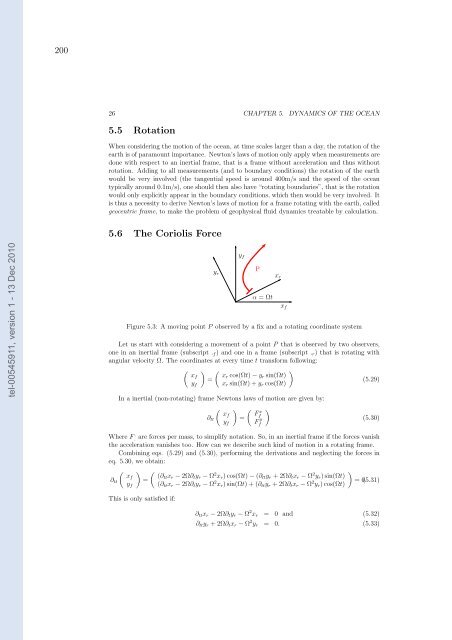Etudes et évaluation de processus océaniques par des hiérarchies ...
Etudes et évaluation de processus océaniques par des hiérarchies ...
Etudes et évaluation de processus océaniques par des hiérarchies ...
You also want an ePaper? Increase the reach of your titles
YUMPU automatically turns print PDFs into web optimized ePapers that Google loves.
200<br />
26 CHAPTER 5. DYNAMICS OF THE OCEAN<br />
5.5 Rotation<br />
When consi<strong>de</strong>ring the motion of the ocean, at time scales larger than a day, the rotation of the<br />
earth is of <strong>par</strong>amount importance. Newton’s laws of motion only apply when measurements are<br />
done with respect to an inertial frame, that is a frame without acceleration and thus without<br />
rotation. Adding to all measurements (and to boundary conditions) the rotation of the earth<br />
would be very involved (the tangential speed is around 400m/s and the speed of the ocean<br />
typically around 0.1m/s), one should then also have “rotating boundaries”, that is the rotation<br />
would only explicitly appear in the boundary conditions, which then would be very involved. It<br />
is thus a necessity to <strong>de</strong>rive Newton’s laws of motion for a frame rotating with the earth, called<br />
geocentric frame, to make the problem of geophysical fluid dynamics treatable by calculation.<br />
5.6 The Coriolis Force<br />
tel-00545911, version 1 - 13 Dec 2010<br />
❑<br />
y r<br />
✻<br />
y f<br />
P<br />
α = Ωt<br />
x r<br />
✯<br />
✲<br />
x f<br />
Figure 5.3: A moving point P observed by a fix and a rotating coordinate system<br />
L<strong>et</strong> us start with consi<strong>de</strong>ring a movement of a point P that is observed by two observers,<br />
one in an inertial frame (subscript . f ) and one in a frame (subscript . r ) that is rotating with<br />
angular velocity Ω. The coordinates at every time t transform following:<br />
(<br />
xf<br />
y f<br />
)<br />
=<br />
(<br />
xr cos(Ωt) − y r sin(Ωt)<br />
x r sin(Ωt) + y r cos(Ωt)<br />
In a inertial (non-rotating) frame Newtons laws of motion are given by:<br />
∂ tt<br />
(<br />
xf<br />
y f<br />
)<br />
=<br />
( F<br />
x<br />
f<br />
F y f<br />
)<br />
)<br />
(5.29)<br />
(5.30)<br />
Where F . . are forces per mass, to simplify notation. So, in an inertial frame if the forces vanish<br />
the acceleration vanishes too. How can we <strong>de</strong>scribe such kind of motion in a rotating frame.<br />
Combining eqs. (5.29) and (5.30), performing the <strong>de</strong>rivations and neglecting the forces in<br />
eq. 5.30, we obtain:<br />
∂ tt<br />
(<br />
xf<br />
y f<br />
)<br />
=<br />
This is only satisfied if:<br />
(<br />
(∂tt x r − 2Ω∂ t y r − Ω 2 x r ) cos(Ωt) − (∂ tt y r + 2Ω∂ t x r − Ω 2 y r ) sin(Ωt)<br />
(∂ tt x r − 2Ω∂ t y r − Ω 2 x r ) sin(Ωt) + (∂ tt y r + 2Ω∂ t x r − Ω 2 y r ) cos(Ωt)<br />
)<br />
= 0. (5.31)<br />
∂ tt x r − 2Ω∂ t y r − Ω 2 x r = 0 and (5.32)<br />
∂ tt y r + 2Ω∂ t x r − Ω 2 y r = 0. (5.33)
















